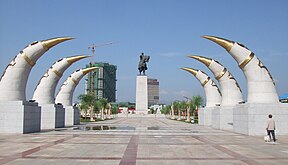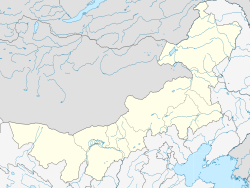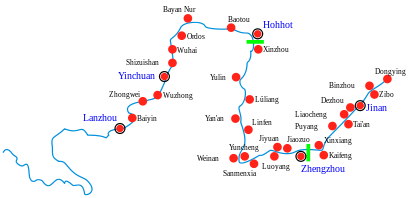Hohhot
Hohhot
Hô hòa hạo đặc thị·ᠬᠥᠬᠡᠬᠣᠲᠠ Huhehot, Kweisui, Kuei-sui | |
|---|---|
 | |
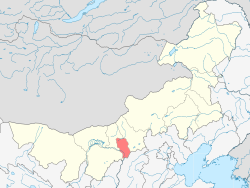 Location of Hohhot City jurisdiction in Inner Mongolia | |
| Coordinates (Gongzhufu Park (Công chủ phủ công viên)):40°50′05″N111°39′23″E/ 40.8346°N 111.6565°E | |
| Country | |
| Region | Inner Mongolia |
| County-level divisions | 10 |
| Township divisions | 116 |
| Established | 1580 |
| Municipal seat | Xincheng District |
| Government | |
| • Type | Prefecture-level city |
| • Body | Hohhot Municipal People's Congress |
| •CCP Secretary | Bao Gang |
| •CongressChairman | Chang Peizhong |
| •Mayor | He Haidong |
| •CPPCCChairman | Bai Yongping |
| Area | |
| •Prefecture-level city | 17,186.1 km2(6,635.6 sq mi) |
| • Urban | 2,065.1 km2(797.3 sq mi) |
| • Metro | 4,830.1 km2(1,864.9 sq mi) |
| Elevation | 1,065 m (3,494 ft) |
| Population (2020 census)[2] | |
| •Prefecture-level city | 3,446,100 |
| • Density | 200/km2(520/sq mi) |
| •Urban | 2,681,758 |
| • Urban density | 1,300/km2(3,400/sq mi) |
| •Metro | 2,944,889 |
| • Metro density | 610/km2(1,600/sq mi) |
| • Majorethnic groups | |
| GDP[3] | |
| •Prefecture-level city | CN¥309.1 billion US$49.6 billion |
| • Per capita | CN¥ 101,492 US$ 16,295 |
| Time zone | UTC+08:00(China Standard) |
| Postal code | 010000 |
| Area code | 471 |
| ISO 3166 code | CN-NM-01 |
| License plate prefixes | Mông A |
| Local Dialect | Jin:Zhangjiakou-Hohhot dialect;Southern Mongolian |
| Administrative division code | 150100 |
| Website | www.huhhot.gov.cn |
Hohhot,[a]formerly known asKweisui,[b]is thecapitalofInner Mongoliain thenorthof thePeople's Republic of China,[5][6]serving as the region's administrative, economic and cultural center.[7]Its population was 3,446,100 inhabitants as of the 2020 census, of whom 2,944,889 lived in the metropolitan area consisting of 4 urban districts (including Hohhot Economic and Development Zone) plus theTümed Left Banner.[8]
The name of the city in Mongolian means "Blue City", although it is also wrongly referred to as the "Green City."[9]The color blue in Mongol culture is associated with the sky, eternity and purity. In Chinese, the name can be translated asQīng Chéng(Chinese:Thanh thành;lit.'Blue/GreenCity')[10]The name has also been variously romanized as Kokotan, Kokutan, Kuku-hoton, Huhohaot'e, Huhehot, Huhhot, Huhot, or Köke qota.[6]
The city is a seat of theInner Mongolia University,the largest regional comprehensive university and the only211 ProjectUniversity in Inner Mongolia.
History
[edit]Early history
[edit]Yunzhong Commandery(Chinese:Vân trung quận) was a historicalcommanderyof China. Its territories were between theGreat WallandYin Mountains,and correspond to part of modern-day Hohhot,BaotouandUlanqabprefectures inInner Mongolia.The central city of Yunzhong was in the suburbs of today's Hohhot.
The commandery was created duringKing Wuling of Zhao's reign after a successful campaign against the Linhu ( lâm hồ ) and Loufan ( lâu phiền ) peoples.[11]After the establishment ofQinandHan dynasty,the commandery became the frontier between Han and theXiongnu.In early Han dynasty, the region saw frequent Xiongnu raids. However, fromEmperor Wu's reign onwards, it became an important base of military operations in thewars against the Xiongnu.[12]In 127 BC, it was from Yunzhong that GeneralWei Qingled a 40,000-men strong cavalry force and conquered the modernHetaoandOrdosregions.
In 2 AD, the commandery administered 11 counties, namely Yunzhong ( vân trung ), Xianyang ( hàm dương ), Taolin ( đào lâm ), Zhenling ( trinh lăng ), Duhe ( độc hòa ), Shaling ( sa lăng ), Yuanyang ( nguyên dương ), Shanan ( sa nam ), Beiyu ( bắc dư ), Wuquan ( võ tuyền ) and Yangshou ( dương thọ ). The population totaled 38,303 households, or 173,270 people.[13]During Eastern Han, 3 counties were abolished, while 3 new counties were added fromDingxiang Commandery.In 140 AD, the population was 5,351 households, or a population of 26,430.[14]Toward the late Han dynasty, the area's population decreased sharply as residents fled from invading northern nomadic peoples, and the commandery was dissolved.[15]
The Tuoba chieftain Gui (calledTuoba Gui) was able to refound theDaiempire in 386. From his capital atShengle(near modern Helingeer). His descendants would, step by step, conquer the north of China, divide theLater Yanrealm into two parts, and subdue theXia(407–431), theLater Qin(384–417) and the many Liang and Yan empires.[16]
Ming and Qing era
[edit]In 1557, theTümedMongol leaderAltan Khanbegan building theDa Zhao Templeon the Tümed plain in order to convince theMing dynasty(1368–1644) government of his leadership of the southern Mongol tribes.[17]The town that grew up around this temple was called the "Blue Town" (Kokegotain Mongolian). The Ming had beenblockadingthe Mongols' access to Chinese iron, cotton, and crop seeds, in order to dissuade them from attacking theNorth China plain.In 1570, Altan Khan successfully negotiated the end of the blockade by establishing avassal-tributary relationship with the Ming, who changed Kokegota's name toGuihua(traditional Chinese:Quy hóa;simplified Chinese:Quy hóa;pinyin:Guīhuà;postal:Kweihua;lit.'Return to Civilization') in 1575. The population of Guihua grew to over 150,000 in the early 1630s as local Mongol princes encouraged the settlement ofHan Chinesemerchants. There were occasional attacks on Guihua by Mongol armies, such as the total razing of the city byLigdan Khanin 1631. Altan Khan and his successors constructed temples and fortresses in 1579, 1602 and 1727. The Tümed Mongols of the area had long since adopted a semiagricultural way of life.Huimerchants gathered north of the gate of the city's fortress, building a mosque in 1693.[18]Their descendants formed the nucleus of the modern Huimin district.
After theManchusfounded theQing dynasty(1644–1912), theKangxi Emperor(reigned 1661–1722) sent troops to control the region,[9]which was of interest to the Qing as a center of study ofTibetan Buddhism.Just 2 km northeast of Guihua the Qing built the strong garrison town ofSuiyuan(traditional Chinese:Tuy viễn;simplified Chinese:Tuy viễn;pinyin:PRCStandard Mandarin:Suíyuǎn,ROCStandard Mandarin:Suīyuǎn), from which they supervised the defense of southwestern Inner Mongolia against Mongol attacks from the north in 1735–39.[19]: 13 [20]Guihua and Suiyuan was merged intoShanxiprovince and became Guihua County (Quy hóa huyện;Quy hóa huyện;Guīhuà Xiàn) of Qing China. French missionaries established aCatholicchurch in Guihua in 1874, but the Christians were forced to flee to Beijing during the antiforeignBoxer Rebellionof 1899–1901.
Republican era
[edit]
In 1913, the government of the newRepublic of Chinaunited the garrison town of Suiyuan and the old town of Guihua asGuisui(traditional Chinese:Quy tuy;simplified Chinese:Quy tuy;pinyin:PRCStandard Mandarin:Guīsuí,ROCStandard Mandarin:Guīsuī;postal:Kweisui). Guisui town was the center of Guisui County (Quy tuy huyện;Quy tuy huyện;PRC:Guīsuí Xiàn,ROC:Guīsuī Xiàn) and the capital ofSuiyuan Provincein northern China. Abubonic plagueoutbreak in 1917 and the connection of Guisui to railway links inShanxi,Shaanxi,Hebei,andBeijinghelped renew the economy of Guisui town by forming links witheastern Chinaand western China'sXinjiangprovince.[19]: 15 In 1918, the American specialist on Inner AsiaOwen Lattimorenoted Guisui's ethnic composition as "a town purelyHan Chineseexcept for the Lama monasteries... the Tümeds are now practically nonexistent and the nearest Mongolians are to be sought at 50 or 60 miles [80 or 100 kilometres] distance on the plateau. "[19]: 15 During the progressiveJapanese invasion of Chinain the 1930s, the Japanese created the puppet state ofMengjiangheaded byPrince De,who renamed Guisui "Blue City" (Hohhot;(Chinese:Hậu hòa thị;pinyin:Hòuhé shì).[21]After thesurrender of Japanin 1945, the Republic of China changed the name back to Guisui.[19]: 16 TheChinese Communist Party's forces drove out GeneralFu Zuoyi,the Republic's commander in Suiyuan, during theChinese Civil War,and after theChinese Communist Revolutionin 1949, Guisui was renamed Hohhot.[19]: 16
People's Republic era
[edit]
During the Civil War, seeking the support of separatist Mongols, the Communists established theInner Mongolia Autonomous Regionin Mongol-minority areas of the Republic's provinces ofSuiyuan,Xing'an,Chahar,andRehe.Guisui was chosen as the region's administrative centre in 1952, replacingZhangjiakou.In 1954, after the establishment of the People's Republic of China, the city was renamed from Guisui toHohhot,though with a different Chinese pronunciation ofHuhehaote.[19]: 16
The city has seen significant development since China'sreform and openingbegan. The city's far east side began development around 2000 and is now home to the municipal government, most of the Autonomous Region's administrative buildings,[22]an artificial lake called Ruyi He,[23]and a large number ofcondominiums,mostly built by the local real estate companyGold Horse International Inc.TheHohhot City Stadium,built on the city's north side, was finished in 2007.[24]
A city with a rich cultural background, Hohhot is known for its historical sites and temples and is one of the major tourist destinations of Inner Mongolia. It is also nationally known as the home of China's dairy giantsMengniuandYili,[25][26]and was declared "Dairy Capital of China" by the China Dairy Industry Association and the Dairy Association of China in 2005.[27]
Geography
[edit]
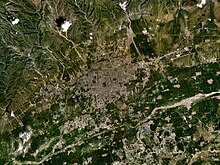
Located in the south central part of Inner Mongolia, Hohhot is encircled by the Daqing Shan (Chinese:Đại thanh sơn;lit.'Great blue Mountains') to the north and theHetao Plateauto the south.[28]
The city'santipodallocation is 22 kilometres (14 mi) from the village ofLos MenucosinRío Negro Provence,Argentina.[29]
Climate
[edit]Hohhot features a coldsemi-arid climate(KöppenBSk), marked by long, cold, and very dry winters; hot, somewhat humid summers; strong winds (especially in spring); andmonsoonalinfluence. The coldest month is January, with a daily mean of −10.7 °C (12.7 °F), while July, the hottest month, averages 23.2 °C (73.8 °F). The annual mean temperature is 7.6 °C (45.7 °F), and the annual precipitation is 411 millimetres (16.2 in), with more than half of it falling in July and August alone. Variability can be very high, however: in 1965 Hohhot recorded as little as 155.1 mm (6.11 in) but six years before that, as much as 929.2 mm (36.58 in), of which over a third (338.6 mm (13.33 in)) only in July.[30]
Hohhot is a popular destination for tourists during the summer months because of the nearby Zhaohegrasslands.More recently, due to desertification, the city seessandstormson almost an annual basis. With monthly percent possible sunshine ranging from 54 percent in November to 66 percent in September, sunshine is abundant year-round, the city receives 2,680 hours of bright sunshine annually. Extreme temperatures have ranged from −32.8 °C (−27 °F) on 6 February 1951 to 38.9 °C (102 °F) on 30 July 2010, though unofficially a record low of −36.2 °C (−33 °F) was recorded in January 1930.[31][32]
| Climate data for Hohhot, elevation 1,154 m (3,786 ft), (1991–2020 normals, extremes 1915–present) | |||||||||||||
|---|---|---|---|---|---|---|---|---|---|---|---|---|---|
| Month | Jan | Feb | Mar | Apr | May | Jun | Jul | Aug | Sep | Oct | Nov | Dec | Year |
| Record high °C (°F) | 10.6 (51.1) |
17.0 (62.6) |
23.7 (74.7) |
33.4 (92.1) |
35.0 (95.0) |
37.2 (99.0) |
38.9 (102.0) |
36.8 (98.2) |
32.7 (90.9) |
26.5 (79.7) |
20.4 (68.7) |
11.6 (52.9) |
38.9 (102.0) |
| Mean daily maximum °C (°F) | −4.8 (23.4) |
0.8 (33.4) |
8.4 (47.1) |
17.1 (62.8) |
23.4 (74.1) |
27.8 (82.0) |
29.1 (84.4) |
27.2 (81.0) |
22.1 (71.8) |
14.5 (58.1) |
4.7 (40.5) |
−3.3 (26.1) |
13.9 (57.1) |
| Daily mean °C (°F) | −10.7 (12.7) |
−5.7 (21.7) |
1.7 (35.1) |
10.0 (50.0) |
16.6 (61.9) |
21.4 (70.5) |
23.2 (73.8) |
21.4 (70.5) |
15.6 (60.1) |
7.7 (45.9) |
−1.3 (29.7) |
−8.8 (16.2) |
7.6 (45.7) |
| Mean daily minimum °C (°F) | −15.3 (4.5) |
−11 (12) |
−4.2 (24.4) |
3.0 (37.4) |
9.2 (48.6) |
14.7 (58.5) |
17.4 (63.3) |
15.7 (60.3) |
9.7 (49.5) |
2.1 (35.8) |
−5.8 (21.6) |
−13.1 (8.4) |
1.9 (35.4) |
| Record low °C (°F) | −36.2 (−33.2) |
−32.8 (−27.0) |
−21.1 (−6.0) |
−12.2 (10.0) |
−4 (25) |
2.3 (36.1) |
8.3 (46.9) |
4.6 (40.3) |
−3.9 (25.0) |
−11.1 (12.0) |
−20.5 (−4.9) |
−29.1 (−20.4) |
−36.2 (−33.2) |
| Averageprecipitationmm (inches) | 2.2 (0.09) |
4.6 (0.18) |
9.8 (0.39) |
13.5 (0.53) |
33.3 (1.31) |
54.6 (2.15) |
115.2 (4.54) |
84.6 (3.33) |
61.0 (2.40) |
20.9 (0.82) |
8.3 (0.33) |
3.4 (0.13) |
411.4 (16.2) |
| Average precipitation days(≥ 0.1 mm) | 2.2 | 2.3 | 3.1 | 3.6 | 6.7 | 9.9 | 12.4 | 10.7 | 9.1 | 4.8 | 2.9 | 2.2 | 69.9 |
| Average snowy days | 3.4 | 3.6 | 3.7 | 1.4 | 0.2 | 0 | 0 | 0 | 0.1 | 0.6 | 3.4 | 3.8 | 20.2 |
| Averagerelative humidity(%) | 56 | 47 | 39 | 33 | 36 | 44 | 56 | 59 | 57 | 54 | 54 | 55 | 49 |
| Averagedew point°C (°F) | −18 (0) |
−16 (3) |
−12 (10) |
−8 (18) |
−1 (30) |
7 (45) |
13 (55) |
12 (54) |
6 (43) |
−2 (28) |
−10 (14) |
−16 (3) |
−4 (25) |
| Mean monthlysunshine hours | 159.0 | 188.3 | 237.1 | 262.8 | 281.5 | 262.3 | 252.1 | 251.0 | 233.0 | 223.9 | 174.4 | 155.5 | 2,680.9 |
| Percentpossible sunshine | 53 | 62 | 64 | 65 | 63 | 58 | 55 | 63 | 66 | 59 | 54 | 60 | 60 |
| Source 1:China Meteorological Administration[33][34] | |||||||||||||
| Source 2: Weather China[35]all-time extreme temperature[36]
Source 3:Time and Date(dewpoints, between 1985–2015),[37]Pogodaiklimat.ru (extremes)[38] | |||||||||||||
Administrative divisions
[edit]The city is administratively at the prefecture-level, meaning that it administers both its urban area and the rural regions in its vicinity. The administrative area includes 4 counties, 4 districts, and a county-levelbanner;they are further divided into 20 urban sub-districts, and 96 townships. The data here represented is in km2and uses data from the 2010 Census.
| Map | |||||||
|---|---|---|---|---|---|---|---|
| English Name | Mongolian | Simplified Chinese | Pinyin | Area | Population | Density | |
| City Proper | |||||||
| Huimin District (Hodong'arad District) |
ᠬᠣᠳᠣᠩ ᠠᠷᠠᠳ ᠤᠨ ᠲᠣᠭᠣᠷᠢᠭ (Qotoŋ Arad-un toɣoriɣ) |
Hồi dân khu | Huímín Qū | 194.4 | 394,555 | 2,030 | |
| Xincheng District (Xinhot District) |
ᠰᠢᠨᠡ ᠬᠣᠲᠠ ᠲᠣᠭᠣᠷᠢᠭ (Sin-e Qota toɣoriɣ) |
Tân thành khu | Xīnchéng Qū | 660.6 | 567,255 | 859 | |
| Yuquan District | ᠢᠤᠢ ᠴᠢᠤᠸᠠᠨ ᠲᠣᠭᠣᠷᠢᠭ (Iui čiuvan toɣoriɣ) |
Ngọc tuyền khu | Yùquán Qū | 207.2 | 383,365 | 1,850 | |
| Saihan District | ᠰᠠᠶᠢᠬᠠᠨ ᠲᠣᠭᠣᠷᠢᠭ (Sayiqan toɣoriɣ) |
Tái hãn khu | Sàihǎn Qū | 1,002.9 | 635,599 | 634 | |
| Rural | |||||||
| Togtoh County | ᠲᠣᠭᠲᠠᠬᠤ ᠰᠢᠶᠠᠨ (Toɣtaqu siyan) |
Thác khắc thác huyện | Tuōkètuō Xiàn | 1,407.8 | 200,840 | 143 | |
| Wuchuan County | ᠦᠴᠤᠸᠠᠨ ᠰᠢᠶᠠᠨ (Üčuvan siyan) |
Võ xuyên huyện | Wǔchuān Xiàn | 4,682.3 | 108,726 | 23 | |
| Horinger County | ᠬᠣᠷᠢᠨ ᠭᠡᠷ ᠰᠢᠶᠠᠨ (Qorin Ger siyan) |
Hòa lâm cách nhĩ huyện | Hélíngé'ěr Xiàn | 3,447.8 | 169,856 | 49 | |
| Qingshuihe County | ᠴᠢᠩ ᠱᠦᠢ ᠾᠧ ᠰᠢᠶᠠᠨ (Čiŋ šüi hė siyan) |
Thanh thủy hà huyện | Qīngshuǐhé Xiàn | 2,859 | 93,887 | 33 | |
| Tumed Left Banner (Tumed Jun Banner) |
ᠲᠦᠮᠡᠳ ᠵᠡᠭᠦᠨ ᠬᠣᠰᠢᠭᠤ (Tümed Jegün qosiɣu) |
Thổ mặc đặc tả kỳ | Tǔmòtè Zuǒ Qí | 2,765 | 312,532 | 113 | |
Demographics
[edit]| Year | Pop. | ±% |
|---|---|---|
| 1953 | 792,600 | — |
| 1964 | 1,118,600 | +41.1% |
| 1982 | 1,645,200 | +47.1% |
| 1990 | 1,911,600 | +16.2% |
| 2000 | 2,437,900 | +27.5% |
| 2010 | 2,866,600 | +17.6% |
| Population size may be affected by changes on administrative divisions. | ||
The urban population of Hohhot has increased rapidly since the 1990s. According to the2010 Census,the population of Hohhot had reached 2,866,615 people, 428,717 more inhabitants than in 2000 (the average annual demographic growth for the period 2000–2010 was of 1.63 percent).[8][39]Its built-up (or metro) area is home to 1,980,774 inhabitants (4 urban districts).
The majority of the population of Hohhot areHan Chinese,representing 87.16 percent of the total population in 2010. Most Han in Hohhot, if their ancestry is traced several decades back, have ancestors fromShanxi,northeast China,orHebei.Most Mongols in the city speakChinese.A 1993 survey conducted byInner Mongolia Universityfound that only 8 percent of Tümed Mongols (the majority tribe in Hohhot) could speak theMongolian language.[19]: 15 A significant portion of the population is of mixed ethnic origin. According to the anthropologist William Jankowiak, author of the bookSex, Death, and Hierarchy in a Chinese City(1993), there is "relatively little difference between minority culture and Han culture" in Hohhot, with differences concentrating around relatively minor attributes such as food and art, and similarities abounding over fundamental issues of ethics, status, life goals, and worldview.[19]: 5
Ethnic groups in Hohhot, according to the 2000 census, were:
| Ethnicity | Population | Percentage |
|---|---|---|
| Han Chinese | 2,115,888 | 88.42% |
| Mongol | 204,846 | 8.56% |
| Hui | 38,417 | 1.61% |
| Manchu | 26,439 | 1.10% |
| Daur | 2,663 | 0.11% |
| Korean | 1,246 | 0.05% |
| Miao | 443 | 0.02% |
Economy
[edit]Hohhot is a major industrial center withinInner Mongolia.Together withBaotouandOrdos,it accounts for more than 60 percent of the total industrial output of Inner Mongolia.[40]After Baotou and Ordos, it is the third-largest economy of the province, with GDP of RMB 247.56 billion in 2012, up 11.0 percent year on year.[41]Hohhot accounted for approximately 15.5 percent of the province's total GDP in 2012.[42]It is also the largest consumer center in the region, recording¥102.2 billion retail sales of consumer goods in 2012, an increase of 14.9 percent from 2011.[41]The city has been a central developmental target for theChina Western Developmentproject being pursued by the Central Government. There are many famous enterprises located in Hohhot, including China's largest dairy producer by sales revenue, the Inner Mongolia Yili Industrial Group, and the China Mengniu Dairy Co.[43]
As the economic center of Inner Mongolia, Hohhot's urban area has expanded greatly since the 1990s.CBDshave grown rapidly in all the city's major districts. The completion of a new office tower for the Municipal Government in Eastern Hohhot marked a shift of the city center to the east. Hailiang Plaza (Hải lượng quảng tràng), a 41-floor tower constructed in the city center, became one of the few notable department stores forluxury merchandisein the city.
Major development zones
[edit]- Hohhot Economic and Technological Development Zone
- Hohhot Export Processing Zone
Culture
[edit]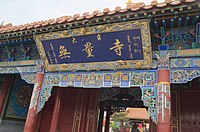
Due to its relatively diverse cultural make-up, and despite its characteristics as a mid-sized Chinese industrial city, the Hohhot street scene has no shortage of ethnic minority elements. Tongdao Road, a major street in the old town area, is decorated with Islamic and Mongol exterior designs on all its buildings. A series of government initiatives in recent years have emphasized Hohhot's identity with ethnic minority groups, especially in increasing Mongol-themed architecture around the city. By regulation, all street signs and public transportation announcements are in both Chinese and Mongolian.[44]
Dialect
[edit]Older Hohhot residents mostly tend to converse in theHohhot dialect,a branch of theJin languagefrom neighbouringShanxiprovince. This spoken form can be difficult to understand for speakers of otherMandarin Chinesedialects. The newer residents, mostly concentrated in Xincheng and Saihan Districts, speak Hohhot-based Mandarin, the majority also with a noticeable accent and some unique vocabulary.
Cuisine
[edit]Food specialty in the area is mostly focused on Mongol cuisine and dairy products. Commercially, Hohhot is known for being the base of the nationally renowned dairy giantsYiliandMengniu.The Mongol drinksuutei tsai(Chinese:Nãi trà;pinyin:nǎichá;lit.'milk tea'), has become a typical breakfast selection for anyone living in or visiting the city.[45]The city also has rich traditions in the making ofhot potandshaomai,a type of traditionalChinesedumplingserved asdim sum.[46]
Transportation
[edit]Airport
[edit]Hohhot'sBaita International Airport(IATA:HET) is located about 14.3 km (8.9 mi) east of the city centre by car. It has direct flights to larger domestic cities includingBeijing,Tianjin,[47]Shanghai, Shenzhen, Chengdu, and others. It also has flights toTaichung,[48]Hong Kong,andUlaanbaatar,Mongolia.
Railway
[edit]Hohhot lies on theJingbao Railwayfrom Beijing to Baotou, and is served by two railway stations:Hohhot railway stationandHohhot East railway station.[49]The line began operation in 1921.[50]Trainsto Beijing link to destinations to the south and thenortheast.The most prominent rail link with Beijing is the overnight K90 train, which has served the Hohhot-Beijing line since the 1980s and is referred to colloquially as the "9-0". Westbound trains go through Baotou andLanzhou.There are also rail links to most major Inner Mongolian cities and toUlaanbaatar,Mongolia.
Because the quickest trip to Beijing takes around six and a half hours despite the relatively close proximity of the two cities, plans forhigh-speed railwere discussed extensively prior to the construction of a high-speed railway station beginning in 2008. The station was completed in 2011 and initially serviced only ordinary lines. In January 2015, CRH opened its first D-series (dongchezu) route in Inner Mongolia in the Baotou-Hohhot-Jiningcorridor, shortening travel time between Inner Mongolia's two largest cities to a mere 50 minutes.[51]This line reached a maximum speed of 200 km/h (124 mph) between Hohhot and Baotou. Another high-speed rail linelinking Hohhot to Zhangjiakouand the plannedBeijing-Zhangjiakourailway are due for completion in 2017, and are designed to operate at 250 km/h (155 mph). The section between Hohhot and Ulanqab (Jining) opened in August 2017; travel time between the two cities was shortened to 40 minutes.[52]
Expressways
[edit]An expressway built in 1997 (then known as the Hubao Expressway) links Hohhot withBaotou.In recent years this expressway has been expanded eastwards toJiningandZhangjiakou,and on toBeijingas part of theG6 Beijing–Lhasa Expressway(Jingzang Expressway). The city is on the route ofChina National Highway 110,which runs fromYinchuantoBeijing.China National Highway 209begins in Hohhot and carries traffic southbound towards southern China, with its terminus inGuangxi.Hohhot is connected to its northern counties by the Huwu Highway, which was completed in 2006. Previously, travel to the northern counties had required lengthy navigation through mountainous terrain.
Long-distance buses connect Hohhot to outlying counties, the cities of Baotou,Wuhai,andOrdos,and other areas in Inner Mongolia.
Public transport & Roadways
[edit]Hohhot's major north–south thoroughfares are called roads (Lu) and its east–west thoroughfares are called streets (Jie). The largest elevated interchange is near the site of the city's Drum Tower (Gulou), after which it is named. Several major streets are named after Inner Mongolian leagues and cities; among these, Hulun Buir, Jurim (now Tongliao), Ulaanhad (Now Chifeng), Xilin Gol, and Xing'an run north–south, while Bayannur, Hailar, Ulaanqab, and Erdos run east–west.
The city's public transit system is composed of nearly one hundred bus routes and a large fleet of taxicabs, which are normally green or blue. Bus fare is 1 yuan; taxi fares begin at 8 yuan.
Metro
[edit]TheHohhot Metrois in operation. Line 1 opened on 29 December 2019.[53]
Education
[edit]Universities located in Hohhot include:
- Inner Mongolia University of Finance and Economics
- Inner Mongolia University,only 211 Project University in Inner Mongolia.[54]
- Inner Mongolia University of Agriculture
- Inner Mongolia Normal University
- Inner Mongolia University of Technology
- Inner Mongolia College of Medicine
- Inner Mongolia College of Finance and Economics
- Hohhot College of Education
- Hohhot College of Police
- Honder College of Inner Mongolia Normal University
High Schools located in Hohhot include:
- Hohhot No.2 Middle School
- Affiliated Middle School to Inner Mongolia Normal University
- Hohhot experimental middle school
- Hohhot No.1 Middle School
Sports
[edit]Hohhot lacked a professional soccer team untilShenyang Dongjin F.C.relocated to Hohhot, changing their name to Hohhot Dongjin, in 2012.[55]They played atHohhot City Stadium,which was newly built in 2007.[24]The club finished in the bottom of the league in the 2012 season and was and relegated toLeague Two.After playing half a season at Hohhot in 2013, the team relocated toLiaoningand choseBenxi City Stadiumas their new home court.[56]
On 14 January 2015,Taiyuan Zhongyou Jiayi F.C.moved to Hohhot and changed their name to Nei Mongu Zhongyou F.C.[57]The team play inChina League Oneand chose Hohhot City Stadium as their home in 2015. The team had been first established as Shanxi Jiayi F.C. on 8 October 2011.[58]
Notable landmarks
[edit]There were over 50 Ming and QingBuddhisttemples and towers in Guihua and Suiyuan.
- Zhaojun Tomb(Chiêu quân mộ), located about nine kilometers south of the city center. It is said to be the tomb ofWang Zhaojun,a woman of theHan Empirewho married aXiongnuChanyu(king).
- Baita Pagoda(Bạch tháp), located in the eastern rural area nearing the airport. It was constructed during theLiao Dynasty.The airport of Hohhot is named after Baita Pagoda.
- Da Zhao Temple(Đại triệu), located in the centre of Guihua town. It was constructed in theNorthern Yuan Dynastyand is the oldest Buddhist lama monastery in the city.[59]
- Temple of the Five Pagodas(Ngũ tháp tự), located in the eastern part of Guihua town. It was completed in theQing Dynasty,with architecture very similar to that of Indian temples.[45]On its walls there are more than 1,500 figures of Buddha.
- Residence of Gurun Princess Kejing(Cố luân khác tĩnh công chủ phủ), located at the foot ofYinshan Mountain.It was the mansion of Gurun Princess Kejing of the Qing Dynasty, who was married to a Mongol prince.
- Residence of the General(Tương quân nha thự), located in the centre of Suiyuan town. It was the residence and office building of Suiyuan Generals of the Qing Dynasty.
- Great Mosque of Hohhot(Thanh chân đại tự), located out of the northern gate of Guihua town. It was constructed during theQing Dynasty.
- Inner Mongolia Museum(Nội mông cổ bác vật viện). Main exhibits include dinosaur fossils, historical artifacts of nomadic peoples, and the cultural life of modern nomadic peoples.
- Qingcheng Park(Thanh thành công viên), formerly People's Park, in the city center[60]
-
The sculpture of "Milk Capital" symbol
-
Great Mosque of Hohhot
See also
[edit]Notes
[edit]- ^/hoʊˈhɒt/;[4]Mongolian:Classical:ᠬᠥᠬᠡᠬᠣᠲᠠ,Cyrillic:Хөх хот,Latin:Höh hot,Mongolian pronunciation:[ˈxɵx‿χɔʰt];Chinese:Hô hòa hạo đặc;pinyin:Hūhéhàotè;abbreviatedHô thị;Hūshì
- ^traditional Chinese:Quy tuy;simplified Chinese:Quy tuy;pinyin:PRCStandard Mandarin:Guīsuí,ROCStandard Mandarin:Guīsuī
References
[edit]- ^Ministry of Housing and Urban-Rural Development,ed. (2019).China Urban Construction Statistical Yearbook 2017.Beijing: China Statistics Press. p. 48. Archived fromthe originalon 18 June 2019.Retrieved11 January2020.
- ^"Nèi Mĕnggŭ / Inner Mongolia (China): Prefectural Division & Major Cities – Population Statistics, Maps, Charts, Weather and Web Information".
- ^Nội mông cổ tự trị khu thống kế cục, quốc gia thống kế cục nội mông cổ điều tra tổng đội (2016).《 nội mông cổ thống kế niên giám -2016》.Trung quốc thống kế xuất bản xã.ISBN978-7-5037-7901-5.
- ^"Hohhot".LexicoUK English Dictionary.Oxford University Press.Archived fromthe originalon 18 May 2021.
- ^"Illuminating China's Provinces, Municipalities and Autonomous Regions".PRC Central Government Official Website. 2001.Retrieved28 May2014.
- ^abSolovʹev, Sergeĭ Mikhaĭlovich(1998),History of Russia,vol. 23, Academic International Press, p. 178,ISBN9780875691930
- ^The New Encyclopædia Britannica,15th Edition (1977), Vol. I, p. 275.
- ^abWang, Tong ( vương đồng ).Hô hòa hạo đặc thị 2010 niên đệ lục thứ toàn quốc nhân khẩu phổ tra chủ yếu sổ cư.Nội mông cổ nhật báo[Inner Mongolia Post].Retrieved13 July2015– via Inner Mongolia News.
- ^abPerkins (1999), p. 212.
- ^Chinese "qing" has traditionally been a color between "blue" and "green" in English, leading some modern sources to translateQing Chenginto English as "Green City" instead of "Blue City," including, for example,the official website of HohhotArchived15 May 2009 at theWayback Machine.
- ^Records of the Grand Historian,Chapter 50.
- ^Book of Han,Chapter 64.
- ^Book of Han,Chapter 28.
- ^Book of Later Han,Chapter 113.
- ^Book of Jin,Chapter 14.
- ^"Northern Dynasties Period Event History (www.chinaknowledge.de)".
- ^"Dazhao Temple".Travel China Guide.Retrieved12 January2013.
- ^Zhang, Guanglin (2005).Islam in China.China Intercontinental Press.p. 75.ISBN978-7-5085-0802-3.
- ^abcdefghJankowiak, William R (1993).Sex, Death, and Hierarchy in a Chinese City: An Anthropological Account.Columbia University Press. pp. 5, 11–16.
- ^Traditional dwellings and settlements review: journal of the International Association for the Study of Traditional Environments.International Association for the Study of Traditional Environments. 1998. p. 12.
- ^Lin, Hsiao-ting(2010),Modern China's Ethnic Frontiers: A Journey to the West,Taylor and Francis,pp.43,49,ISBN9780415582643
- ^Wasserman, Adam."Gold Horse International, Inc. Updates Status of Key Real Estate Development Projects for 2009".Gale, Cengage Learning.PR Newswire Association LLC. Archived fromthe originalon 7 December 2017.Retrieved20 July2015.
- ^"Guggenheim S&P High Income Infrastructure ETF".realpennies.Retrieved20 July2015.
- ^abNội mông cổ tân kiến hô hòa hạo đặc thị thể dục tràng lạc thành khả dung nạp cận 6 vạn nhân – tân nông thôn thương võng.Ministry of Commerce of the People's Republic of China.Archived fromthe originalon 11 July 2012.Retrieved27 May2014.
- ^"Background of Inner Mongolia Yili Industrial Group Co., Ltd".Archived fromthe originalon 1 January 2007.Retrieved20 July2015.
- ^"Profile of Inner Mongolia Yili Industrial Group Company Limited".Archived fromthe originalon 26 June 2008.Retrieved20 July2015.
- ^"World Dairy Industry Conference".regional.chinadaily.com.cn.Retrieved27 August2024.
- ^Encyclopedia Americana.Grolier Incorporated.April 2001. p. 510.ISBN978-0-7172-0134-1.
- ^"Antipode of Hohhot, China – Geodatos".www.geodatos.net.Retrieved20 January2023.
- ^Huhehaote rainfall
- ^Trung quốc khí tượng khoa học sổ cư cộng hưởng phục vụ võng.China Meteorological Administration.Archived fromthe originalon 2 March 2015.Retrieved22 February2014.
- ^"Trung quốc các địa thành thị đích lịch sử tối đê khí ôn".weibo.com.Retrieved9 September2024.
- ^1991-2020 normals"Climate averages from 1991 to 2020".China Meteorological Administration.Archived fromthe originalon 17 April 2023.
- ^1981-2010 extremesTrung quốc khí tượng sổ cư võng – WeatherBk Data(in Simplified Chinese).China Meteorological Administration.Retrieved14 April2023.
- ^Hô hòa hạo đặc thành thị giới thiệu dĩ cập khí hầu bối cảnh phân tích.Weather China(in Chinese (China)).Retrieved27 July2015.
- ^"Trung quốc các địa thành thị đích lịch sử tối đê khí ôn".Retrieved10 September2024.
- ^"Climate & Weather Averages at Hohhot weather station (53463)".Time and Date.Retrieved6 February2022.
- ^"Climate Hohhot".Pogoda.ru.net.Retrieved15 July2023.
- ^(in Chinese)Compilation by LianXin website.Data from the Sixth National Population Census of the People's Republic of ChinaArchived22 June 2011 at theWayback Machine
- ^Ngạc nhĩ đa tư nhân quân GDP siêu bắc kinh phòng sản nghiệp diện lâm hà chủng cơ ngộ(in Chinese). Archived fromthe originalon 17 December 2014.Retrieved1 February2014.
- ^abHô hòa hạo đặc thị 2012 niên quốc dân kinh tế hòa xã hội phát triển thống kế công báo.Hohhot Municipal Bureau of Statistics(in Chinese). 1 April 2013. Archived fromthe originalon 24 September 2015.Retrieved17 July2015.
- ^"hktdc.com – Profiles of China Provinces, Cities and Industrial Parks".Tdctrade.com.Retrieved1 February2014.
- ^"Programa Conjunto FAO/OMS Sobre Normas Alimentarias"(Archive).Food and Agriculture Organization.p. 30. Retrieved on 10 July 2014. "Inner Mongolia Yili Industrial Group Co. Ltd. No. 8, Jinsi Road, Jinchun Developing Zone 010080 Hohhot P.R. China"
- ^Hô hòa hạo đặc thị xã hội thị diện mông hán lưỡng chủng văn tự tịnh dụng quản lý bạn pháp.National Ethnic Affairs Commission of the People's Republic of China. Archived fromthe originalon 13 July 2015.Retrieved13 July2015.
- ^abLonely Planet (June 2012).Níngxià and Inner Mongolia – Guidebook Chapter.Lonely Planet. p. 25.ISBN978-1-74321-265-3.
- ^Hsiung, Deh-Ta. Simonds, Nina. Lowe, Jason. [2005] (2005). The food of China: a journey for food lovers. Bay Books.ISBN978-0-681-02584-4.p 38.
- ^Xuân vận khai thủy hậu "Thiên tân - hô hòa hạo đặc - a lạp thiện tả kỳ" hàng tuyến thành vi nhiệt điểm.Vô tích vật lưu(in Simplified Chinese). 28 January 2014. Archived fromthe originalon 2 May 2014.Retrieved28 January2014.
- ^Đài loan viễn đông hàng không khán hảo nội mông cổ hạ nguyệt khai thông hô hòa hạo đặc hàng tuyến.Sina News(in Chinese (China)). 28 April 2014.Retrieved28 April2014.
- ^Zhongguo dui wai jing ji mao yi nian jian bian ji wei yuan hui (1993).Almanac of China's foreign economic relations and trade.Hoa nhuận mậu dịch ti tuân hữu hạn công tư. p. 945.
- ^Ngoại quan hoành vĩ tạo hình độc đặc hô hòa hạo đặc đông trạm hoàn mỹ sơ hiện.Xinhua NewsInner Mongolia. 23 September 2008. Archived fromthe originalon 3 March 2016.Retrieved11 July2015.(in Chinese)
- ^Hô hòa hạo đặc chính thức khóa nhập "Động xa" thời đại.Inner Mongolia Xinhua.9 January 2015. Archived fromthe originalon 13 July 2015.Retrieved13 July2015.
- ^Hô trương khách chuyên khai thổ động công, phương tiện tiến kinh chi lộ(in Chinese). China Railways.Retrieved12 November2014.
- ^Quan tuyên! Hô hòa hạo đặc địa thiết 1 hào tuyến 12 nguyệt 29 nhật khai thủy sơ kỳ vận doanh.Hohhot News.27 December 2019. Archived fromthe originalon 24 November 2022.Retrieved30 December2019.
- ^"Inner Mongolia University: A survey of the university".Inner Mongolia University. Archived fromthe originalon 26 February 2009.Retrieved12 March2009.
- ^Đông tiến canh danh chủ tràng lạc hộ hô hòa hạo đặc lão tổng: Chỉ thị hoán liễu cá danh tự.163.comSports.29 February 2012. Archived fromthe originalon 20 March 2012.Retrieved21 July2014.
- ^Hô hòa hạo đặc đông tiến chung vu phản hương vị lai trung ất chủ tràng thiết liêu ninh bổn khê.Thẩm dương vãn báo. 25 July 2013.Retrieved13 July2015.
- ^Quan vu thái nguyên trung ưu gia di túc cầu câu nhạc bộ hữu hạn công tư công thương thiên di tịnh canh danh đích công kỳ.fa.org.cn(in Simplified Chinese). 14 January 2015. Archived fromthe originalon 7 November 2017.Retrieved11 July2015.
- ^Sơn tây gia di túc cầu câu nhạc bộ tại tịnh thành lập.Shanxi News(in Simplified Chinese). Archived fromthe originalon 4 November 2014.Retrieved11 July2015.
- ^Đại triệu tự.97616.net(in Simplified Chinese).
- ^Ký ức trung đích hô thị nhân dân công viên[Hohhot People's Park] (in Chinese). Hohhot News. 24 February 2014. Archived fromthe originalon 13 July 2015.Retrieved2 May2014.
Bibliography
[edit]- Perkins (1999).Encyclopedia of China: The Essential Reference to China, Its History and Culture.Dorothy Perkins. 1st paperback edition: 2000. A Roundtable Press Book, New York, N.Y.ISBN0-8160-4374-4(pbk).
External links
[edit]- Hohhot government websiteArchived18 April 2005 at theWayback Machine(in Chinese)
- Hohhot government website(in Mongolian)
- China Daily newsArchived9 August 2023 at theWayback Machine
 Hohhottravel guide from Wikivoyage
Hohhottravel guide from Wikivoyage






